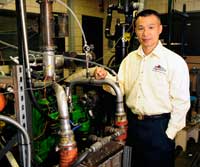Sep 18 2008
The five engines in Song-Charng Kong’s Iowa State University laboratory have come a long way since Karl Benz patented a two-stroke internal combustion engine in 1879.
 Song-Charng Kong, an Iowa State University assistant professor of mechanical engineering, and his students are studying engines in an effort to reduce emissions and improve efficiency. Photo by Bob Elbert - Iowa State University
Song-Charng Kong, an Iowa State University assistant professor of mechanical engineering, and his students are studying engines in an effort to reduce emissions and improve efficiency. Photo by Bob Elbert - Iowa State University
There are fuel injectors and turbochargers and electrical controls. There’s more horsepower, better efficiency, cleaner burning and greater reliability.
But Kong – with the help of 15 graduate students and all kinds of sensors recording engine cylinder pressure, energy release and exhaust emissions – is looking for even more.
Kong, an Iowa State assistant professor of mechanical engineering who keeps a piston by his office computer, is studying engines with the goal of reducing emissions and improving efficiency.
“There is still a lot of work to be done to improve engine performance,” Kong said. “All of this work will lead to incremental improvements.”
And those small improvements can add up when you consider there are more than 250 million registered vehicles on U.S. highways, according to the U.S. Department of Transportation.
Kong and his students are working on a lot of combustion projects in the lab: They’re studying diesel engines with the goal of reducing emissions. They’re developing a computer model of a gasoline engine that will make it much easier and faster to research and develop new engine technologies. They’re figuring out how to optimize new technologies such as multiple fuel injections per combustion cycle.
They’re working with Terry Meyer, an Iowa State assistant professor of mechanical engineering, to use high-speed, laser-based sensors that can record images of injection sprays and combustion inside a cylinder. That can give researchers insights into combustion characteristics and ideas for improvements.
They’re also studying how plastics dissolved in biodiesel affect engine performance. Biodiesel acts as a solvent on certain plastics and that has Kong checking to see if some waste plastic could be recycled by mixing it into fuel.
And they’re studying the combustion of ammonia in engines. Ammonia is relatively easy to store, is fairly dense with hydrogen and doesn’t produce greenhouse gases when it burns. So burning ammonia in engines could be an early step to developing a hydrogen economy.
Kong’s work is supported by grants from Deere & Co., the Ford Motor Co., the U.S. Department of Energy’s Los Alamos National Laboratory, the Ames-based Renewable Energy Group Inc. and the Iowa Energy Center based at Iowa State.
As he showed a visitor around his engine lab recently, pointing out a new turbocharger here or an experimental one-cylinder engine there, Kong said there’s good reason to keep studying engines.
“We want to make these engines better,” Kong said. “In my mind, the internal combustion engine may be the most important combustion system in daily life. Just by improving combustion efficiency by a fraction, we can save a lot of energy for the country and the world.”
And yes, he said, “There is a future for internal combustion engines.”